Westphalia is a small unincorporated community in Falls County, Texas, United States, located 35 mi (56 km) south of Waco on State Highway 320. Westphalia has a strong German and Catholic background. The Church of the Visitation was, until recently, the largest wooden church west of the Mississippi River. Westphalia is mainly noted for its historic church and convents, but also for its meat market and for its annual church picnic, which is one of the largest in the area. Westphalia is also known for the Westphalia Waltz.

The Benninghofen House is a historic residence located in Hamilton, Ohio, United States. Constructed in the 1860s, this house has been named a historic site for its high-quality architecture. Once the home of prominent Hamilton residents, it has been converted into a museum.

The John Scott Farm is a historic farmstead near the community of Shandon, Ohio, United States. Established in the nineteenth century and still in operation in the twenty-first, the farmstead has been named a historic site because of its traditionally built agricultural structures.

The Arnold Homestead is a historic homestead in the city of Huber Heights, a suburb of Dayton, Ohio, United States. Formed at the turn of the nineteenth century, it centers on an 1830s farmhouse that was built for an immigrant family from Virginia.

Cobblestone Farmhouse at 1229 Birdsey Road is a farmhouse in the town of Junius, New York, in Seneca County, New York. It is significant as a well-preserved example of cobblestone architecture, in a vernacular Greek Revival style. North of the house, there is also a large barn believed to date to the late 19th century. This property was listed on the National Register of Historic Places on August 6, 2008. It is the sixth property listed as a featured property of the week in a program of the National Park Service that began in July, 2008.
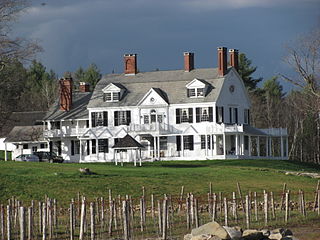
Brook Farm is a historic country estate farm at 4203 Twenty Mile Stream Road in Cavendish, Vermont. It includes one of the state's grandest Colonial Revival mansion houses, and surviving outbuildings of a model farm of the turn of the 20th century. It was listed on the National Register of Historic Places in 1993. The property is now home to the Brook Farm Vineyard.

Pisgah Christian Church is a historic Church of Christ house of worship located outside of Ripley in rural Brown County, Ohio, United States. Constructed in the 1850s for a quarter-century-old congregation, it has been designated a historic site.

The McClelland Homestead is a historic farm in western Lawrence County, Pennsylvania, United States. Located along McClelland Road northeast of Bessemer, the farm complex includes buildings constructed in the middle of the 19th century. It has been designated a historic site because of its well-preserved architecture.
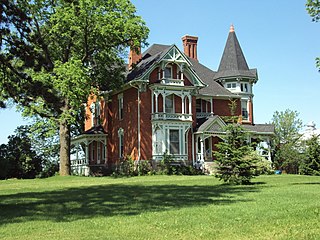
The George B. Horton and Amanda Bradish Farmstead is a privately owned farmhouse that sits on 40 acres of land at 4650 West Horton Road in rural Fairfield Township in Lenawee County, Michigan. It was added to the National Register of Historic Places on February 1, 2007. There are several other buildings on the property, but the main farmhouse was built in 1888 in Queen Anne Style.

The Fort is a prominent historic house in the central portion of the U.S. state of Ohio. Located northeast of the village of North Lewisburg in Union County, this two-story brick building is a local landmark. Built in 1877, it is a square structure, measuring five bays wide on each of its sides. Its foundation is built of ashlar stone, while the hip roof is constructed of imbricated slates of multiple colors. The house's hilltop location makes it visible from a vast distance in all directions. Many of its impressive Italianate architectural elements, such as the ornamental cornice and carven stone lintels, can be distinguished from far away, especially as the house is surrounded by farmland rather than woods. Porches are located on both sides of the house's front of the house, with a two-story bay window placed in the middle of the facade. Chimneys stand at the tops of both side walls.
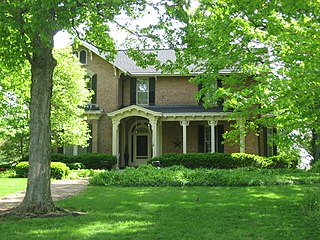
Elmwood Place is a historic farmstead in the southwestern corner of Union County, Ohio, United States. Located along State Route 161 near the community of Irwin, the farmstead comprises six different buildings spread out over an area of 9 acres (3.6 ha).

The Franklin Harris Farmstead is a historic farm complex located outside the village of Salem in Columbiana County, Ohio, United States. Once home to a prominent former soldier, the farmstead includes a high-style farmhouse from the 1890s, and it has been named a historic site.
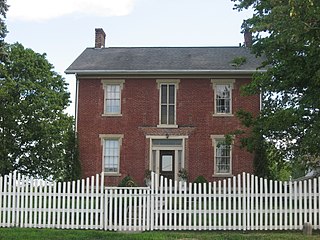
The William Baumgardner Farm is a historic farmstead located near New Carlisle in Miami County, Ohio, United States. Constructed in 1857, the site remains typical of period farmsteads, and it has been named a historic site.

The Smith–Mason Farm is a historic farmstead at Meadow Road and Old Roxbury Road in Harrisville, New Hampshire. First developed in the late 18th century, the property has been adaptively used as a farm, summer estate, and family residence, representing major periods in Harrisville's development. The property was listed on the National Register of Historic Places in 1988.
The Anders and Johanna Olsson Farm is a historic farmstead at 354 West Road in New Sweden, Maine, United States. It includes surviving elements of both a log house and log barn built in the late 19th century by Anders Olsson, a Swedish immigrant. The barn is the only known surviving barn in Maine to have been built during the wave of Swedish immigration in the later decades of the 19th century. The property was listed on the National Register of Historic Places in 1996.

The Stahly–Nissley–Kuhns Farm is a historic farm located at Nappanee, Elkhart County, Indiana. Nappanee was established in 1874. The Farm is part of Amish Acres, which includes the old farmstead and additional structures brought in to show Amish life.

The Lovira Hart, Jr., and Esther Maria Parker Farm is a historic farmstead located at 9491 West Frankenmuth Road in Tuscola Township, Michigan. It was settled in 1836 and has been continuously owned by the same family since that time. It was listed on the National Register of Historic Places in 2004.

The Langford and Lydia McMichael Sutherland Farmstead is a farm located at 797 Textile Road in Pittsfield Charter Township, Michigan. It was listed on the National Register of Historic Places in 2006. It is now the Sutherland-Wilson Farm Historic Site.
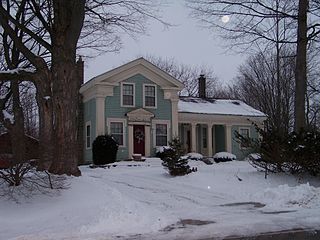
The Jacob Fishbeck Farmstead is a farm located at 5151 Crooked Lake Road in Genoa Township, Michigan. It was listed on the National Register of Historic Places in 2003.

The Gordon Hitt Farmstead is a former farm located at 4561 North Lake Road near Clark Lake, Michigan, United States. It was listed on the National Register of Historic Places in 1994. It now serves as a vacation rental.





















